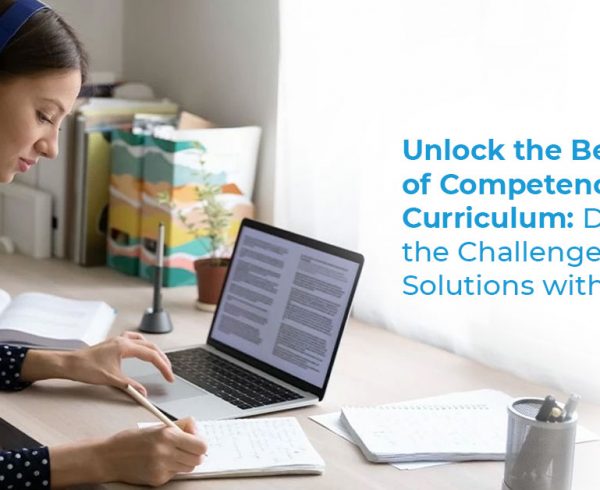Summary
This article discusses the importance of competency based learning and how it can be incorporated into K12 Education.
Also known as mastery-based or proficiency-based learning, competency-based learning is a personalized learning experience that focuses student advancement on the proficiency of skills and academic content. It does not consider age, seat time, or hours spent on a particular subject.
This ensures that the students learn at their own pace and focus more on mastery of knowledge and valuable skills. Basically, ‘how is something learned’ is given as much importance as ‘what is learned’.
Table of Contents:
- The Difference between Traditional Education and Competency-Based Education
- The Importance of Competency-Based Learning
- Tips to Include Competency-Based Learning in K12 Education
- The Final Word
The Difference between Traditional Education and Competency-Based Education
1. Mode of Instruction
Traditional education happens inside a classroom, with a teacher delivering the pre-designed curriculum with little to no differentiation.
In competency-based learning, educators and students work collaboratively to devise adaptive learning models for each student based on interests, learning needs, and real-time data.
2. Evaluation and Assessment
In traditional education, assessments often tend to be inconclusive, as the focus is on the information of the subject learned and not on the practical application of it.
Competency-based assessment aids in determining if the students are learning the necessary skills. It uses formative assessments along with summative assessments.
3. Grading System
In traditional education, the grading scale used to measure a student’s academic performance is norm-referenced.
In competency-based learning, grades indicate the degree of mastery of competencies. If the student fails to earn a course credit, the records specify competencies that need to be re-learned instead of the entire course.
Also Read: The Best 5 Tech Tools That Make K12 Online Education Programs More Rewarding
The Importance of Competency-Based Learning
Traditionally, students’ learning is measured by the time spent studying a subject. However, this approach does not measure the application of content learned, nor does it give educators a chance to accelerate the learning process. This leads to a student’s full potential being untapped, which, in turn, becomes the cause of their college and career downfall.
As teaching and learning change drastically, it is the perfect time to respond to students’ academic needs with competency-based learning models.
As strong educational preparation is essential to success in today’s world, educational innovation is the need of the hour. Including competency-based learning in K12 education is a popular practice followed by education institutions in recent times to raise academic standards and ensure that students are better prepared for adult life.
As per the eLearning statistics by the American Institute of Research, 2021, 82% of the educational institutions in the US have implemented competency-based education (CBE) programs or are presently in the process of adopting the curriculum.
Tips to Include Competency-Based Learning in K12 Education
As much as including competency-based learning in the K12 curriculum is essential, schools and students might have to face a few roadblocks initially while incorporating it. Hence, to help ease this stress, we are here with a few simple tips and tricks to make this personalized learning program a great success.
Read on to learn more and make your job a little easier.
1. Knowing Your Students and Devising Personalized Learning Paths
Understanding your students’ backgrounds, learning and cognitive styles, interests, weaknesses, and strengths is of utmost importance. This will help you develop a clear vision and set realistic goals for competency-based learning.
There should be a learning map to focus on every student’s characteristics. This will act as a starting point for each student. It will facilitate teachers to provide customized learning experiences that aid students in addressing their weaknesses and drawing on their strengths.
Some of the methods you can opt for to provide customized instruction are:
- Setting up flexible classrooms through learning stations and playlists of self-guided activities
- Opting for a flipped classroom model
- Using task cards
- Grouping students with the same learning style
- Peer tutoring, etc.
Thus, student-centric learning leads to better and more effective learning now and in the future. It leads to each student being successful in his or her unique way.
2. Designing a Competency-Based Curriculum and Implementing It into K12 Education
Educators and institutions must review and analyze their current curriculum. They should take measures to identify competencies and standards that align with competency-based education (CBE) principles. They can do so by following the below-mentioned steps:
- Collectively defining and honing the essential skills students should obtain in each subject or discipline.
- By creating learning progressions that outline how students can progress from one competency to the next, teachers can identify the need to provide support to each student on specific skills. They must also lay down explicit and measurable learning objectives for each competency and ensure that they are in alignment with state or national standards.
- Finally, a competency-based curriculum must be dynamic. It should be revised from time to time. Instructional materials, resources, and assessments should be altered or modified to correspond with the newly designed competencies and learning objectives.
- When the framework to implement competency-based learning is ready, establish a timeline and allocate resources for the implementation process of CBE in K12 education.
3. Developing a CBE Ecosystem
For a successful transition to CBE, it is essential to acquaint the teachers and staff with CBE principles, instructional strategies, and assessment methods. Offering training on various competency-based learning techniques and providing professional development opportunities is a major force behind a successful CBE implementation.
Some ways to develop these skills and competencies to facilitate the implementation of CBE are:
- Establishing coaching programs to render ongoing support and guidance to educators during the CBE implementation process
- Organizing teacher-led workshops or professional learning communities to nurture a culture of teamwork and peer learning
- Spreading awareness and conveying the benefits and goals of competency-based learning as one of the key K12 learning strategies to teachers, students, and parents.
To check if the CBE implementation is smooth and effective, gather regular feedback from teachers, students, and parents about their experiences with the CBE implementation. Remember, the shift to CBE is a huge change that requires dedication, teamwork, cooperation, and optimum utilization of resources at different levels.
Check out EXCLUSIVE: Hurix Minibook: Immersive Learning for the WIN in Education!
The Final Word
In recent years, this learning approach has seen an upward trend. To make students workplace-ready by implementing CBE is the goal of almost every educational institution. Although the concept of competency-based learning has numerous benefits, only a few instructors and designers can properly implement it.
Hurix Digital is one such organization that offers a range of digital learning solutions to K12 schools. They help in creating competency-based curricula for K12 institutions and schools with their team of expert instructional designers to ensure an interesting and heuristic experience for the learners as they master skills.
To learn more about these services, you can get in touch with them.










